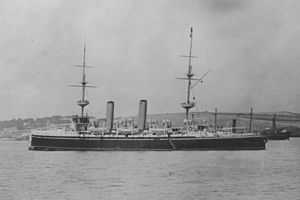HMS Juno (1895)
 Juno circa. 1901 | |
| Career (United Kingdom) | |
|---|---|
| Name: | HMS Juno |
| Namesake: | Juno |
| Builder: | Naval Construction & Armaments Co., Barrow-in-Furness |
| Laid down: | 22 June 1894 |
| Launched: | 16 November 1895 |
| Completed: | 16 June 1897 |
| Fate: | Sold for scrap, 24 September 1920 |
| General characteristics | |
| Class and type: | Eclipse-class protected cruiser |
| Displacement: | 5,600 long tons (5,690 t) |
| Length: | 350 ft (106.7 m) |
| Beam: | 53 ft 6 in (16.3 m) |
| Draught: | 20 ft 6 in (6.25 m) |
| Installed power: | 9,600 ihp (7,200 kW) 8 cylindrical boilers |
| Propulsion: | 2 shafts, 2 Inverted triple-expansion steam engines |
| Speed: | 18.5 knots (34.3 km/h; 21.3 mph) |
| Complement: | 450 |
| Armament: | As built: 5 × QF 6-inch (152 mm) guns 6 × QF 4.7-inch (120 mm) guns 6 × 3-pounder QF guns 3 × 18-inch torpedo tubes After 1905: 11 × six-inch QF guns 9 × 12-pounder QF guns 7 × 3-pounder QF guns 3 × 18-inch torpedo tubes |
| Armour: | Gun shields: 3 in (76 mm) Engine hatch: 6 in (152 mm) Decks: 1.5–3 in (38–76 mm) Conning tower: 6 in (152 mm) |
HMS Juno was an Eclipse-class protected cruiser built for the Royal Navy in the mid-1890s.
Juno was assigned to the 11th Cruiser Squadron operating from Ireland.
In 1901, she was one of two escort ships for HMS Ophir, which carried the Duke and Duchess of Cornwall and York (later King George V and Queen Mary) during their tour of the British Empire.
The following year she served in the cruiser squadron under the command of Captain Henry Peter Routh. In May 1902 she was taken into Portsmouth for a refit, and later that year she served in the 1902 Coronation review.[1]
In 1915 she was sent to the Persian Gulf and took part in an engagement at Bushire in July – August 1915 against Tangistani raids under Rais Ali Delvari.
Juno was sold for scrap in 1920.
In 1902 Juno was commanded by David Beatty.
Footnotes
- ↑ "Naval & Military intelligence" The Times (London). Thursday, 1 May 1902. (36756), p. 6.
References
- Chesneau, Roger; Kolesnik, Eugene M., eds. (1979). Conway's All the World's Fighting Ships 1860–1905. Greenwich, UK: Conway Maritime Press. ISBN 0-8317-0302-4.
- Gardiner, Robert; Gray, Randal, eds. (1984). Conway's All the World's Fighting Ships: 1906–1921. Annapolis, Maryland: Naval Institute Press. ISBN 0-85177-245-5.
- McBride, Keith (2012). "The Cruiser Family Talbot". In John Jordan. Warship 2012. London: Conway. pp. 136–41. ISBN 978-1-84486-156-9.